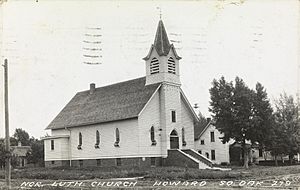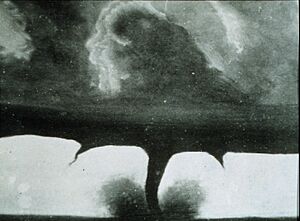Howard, South Dakota facts for kids
Quick facts for kids
Howard, South Dakota
|
|
|---|---|

Location in Miner County and the state of South Dakota
|
|
| Country | United States |
| State | South Dakota |
| County | Miner |
| Incorporated | 1881 |
| Area | |
| • Total | 0.96 sq mi (2.50 km2) |
| • Land | 0.96 sq mi (2.50 km2) |
| • Water | 0.00 sq mi (0.00 km2) |
| Elevation | 1,562 ft (476 m) |
| Population
(2020)
|
|
| • Total | 848 |
| • Density | 878.76/sq mi (339.31/km2) |
| Time zone | UTC-6 (Central (CST)) |
| • Summer (DST) | UTC-5 (CDT) |
| ZIP code |
57349
|
| Area code(s) | 605 |
| FIPS code | 46-30460 |
| GNIS feature ID | 1267429 |
Howard is a city located in Miner County, South Dakota, in the United States. In 2020, about 848 people lived there. It is the main city and the county seat (the place where the county government is) for Miner County.
Contents
History of Howard
The city of Howard was started in 1881. This happened soon after the Southern Minnesota Railway built its tracks to this spot. The city got its name from Howard Farmer. He was the son of J. D. Farmer, who owned the land where the town was built.
In 1883, Miner and Sanborn counties were officially created. At that time, Howard was chosen as the county seat for Miner County.
One of the very first photos ever taken of a tornado was near Howard. This famous picture shows the 1884 Howard, South Dakota tornado.
Howard also holds a special record for libraries. The first public library in all of Dakota Territory was the Howard Public Library. It officially opened in 1886.
In 2001, Howard became a leader in green energy. It was the first city in South Dakota to own and run its own wind turbines. These turbines help create electricity from wind.
Since 2001, the community has grown a lot. Over 200 new jobs have been created in Howard. The money the city made from sales taxes also went up a lot. From 1996 to 2008, sales tax income increased by 123%.
Geography and Climate
Howard is located in the southeastern part of South Dakota. It is right on South Dakota Highway 34, which is a main road.
The United States Census Bureau says the city covers about 0.95 square miles (2.5 square kilometers). All of this area is land.
Howard's Climate
Howard experiences a wide range of weather throughout the year. The warmest month is usually July, and the coldest is January.
| Climate data for Howard, South Dakota (1991−2020 normals, extremes 1893−present) | |||||||||||||
|---|---|---|---|---|---|---|---|---|---|---|---|---|---|
| Month | Jan | Feb | Mar | Apr | May | Jun | Jul | Aug | Sep | Oct | Nov | Dec | Year |
| Record high °F (°C) | 63 (17) |
70 (21) |
89 (32) |
96 (36) |
109 (43) |
108 (42) |
113 (45) |
113 (45) |
106 (41) |
95 (35) |
80 (27) |
67 (19) |
113 (45) |
| Mean maximum °F (°C) | 46.2 (7.9) |
51.5 (10.8) |
69.1 (20.6) |
81.0 (27.2) |
87.7 (30.9) |
92.2 (33.4) |
95.0 (35.0) |
93.1 (33.9) |
89.1 (31.7) |
81.0 (27.2) |
65.3 (18.5) |
49.0 (9.4) |
97.0 (36.1) |
| Mean daily maximum °F (°C) | 29.1 (−1.6) |
34.1 (1.2) |
46.8 (8.2) |
61.0 (16.1) |
72.5 (22.5) |
82.3 (27.9) |
87.3 (30.7) |
84.9 (29.4) |
77.4 (25.2) |
62.6 (17.0) |
46.9 (8.3) |
33.1 (0.6) |
59.8 (15.4) |
| Daily mean °F (°C) | 16.8 (−8.4) |
21.5 (−5.8) |
33.8 (1.0) |
46.4 (8.0) |
58.7 (14.8) |
69.1 (20.6) |
73.7 (23.2) |
71.3 (21.8) |
62.9 (17.2) |
48.8 (9.3) |
34.1 (1.2) |
21.6 (−5.8) |
46.6 (8.1) |
| Mean daily minimum °F (°C) | 4.6 (−15.2) |
9.0 (−12.8) |
20.8 (−6.2) |
31.8 (−0.1) |
44.8 (7.1) |
55.8 (13.2) |
60.2 (15.7) |
57.6 (14.2) |
48.4 (9.1) |
35.1 (1.7) |
21.3 (−5.9) |
10.2 (−12.1) |
33.3 (0.7) |
| Mean minimum °F (°C) | −17.2 (−27.3) |
−11.5 (−24.2) |
−1.9 (−18.8) |
17.7 (−7.9) |
31.5 (−0.3) |
45.3 (7.4) |
50.2 (10.1) |
48.2 (9.0) |
33.9 (1.1) |
19.1 (−7.2) |
4.0 (−15.6) |
−11.0 (−23.9) |
−21.0 (−29.4) |
| Record low °F (°C) | −46 (−43) |
−42 (−41) |
−24 (−31) |
1 (−17) |
16 (−9) |
19 (−7) |
34 (1) |
26 (−3) |
13 (−11) |
−11 (−24) |
−23 (−31) |
−36 (−38) |
−46 (−43) |
| Average precipitation inches (mm) | 0.63 (16) |
0.67 (17) |
1.37 (35) |
2.68 (68) |
3.88 (99) |
3.70 (94) |
3.51 (89) |
2.89 (73) |
2.96 (75) |
2.35 (60) |
1.02 (26) |
0.69 (18) |
26.35 (669) |
| Average snowfall inches (cm) | 5.8 (15) |
6.4 (16) |
6.6 (17) |
5.2 (13) |
0.0 (0.0) |
0.0 (0.0) |
0.0 (0.0) |
0.0 (0.0) |
0.0 (0.0) |
1.0 (2.5) |
3.2 (8.1) |
7.6 (19) |
35.8 (91) |
| Average precipitation days (≥ 0.01 in) | 4.6 | 4.6 | 5.4 | 8.6 | 9.9 | 10.7 | 7.4 | 7.1 | 6.6 | 6.1 | 3.8 | 4.8 | 79.6 |
| Average snowy days (≥ 0.1 in) | 3.9 | 3.8 | 2.6 | 1.5 | 0.0 | 0.0 | 0.0 | 0.0 | 0.0 | 0.7 | 1.7 | 3.8 | 18.0 |
| Source: NOAA | |||||||||||||
Population of Howard
| Historical population | |||
|---|---|---|---|
| Census | Pop. | %± | |
| 1900 | 588 | — | |
| 1910 | 1,026 | 74.5% | |
| 1920 | 1,325 | 29.1% | |
| 1930 | 1,224 | −7.6% | |
| 1940 | 1,193 | −2.5% | |
| 1950 | 1,251 | 4.9% | |
| 1960 | 1,208 | −3.4% | |
| 1970 | 1,175 | −2.7% | |
| 1980 | 1,169 | −0.5% | |
| 1990 | 1,156 | −1.1% | |
| 2000 | 1,071 | −7.4% | |
| 2010 | 858 | −19.9% | |
| 2020 | 848 | −1.2% | |
| U.S. Decennial Census | |||
2010 Census Information
In 2010, a census (a count of the population) showed that 858 people lived in Howard. These people lived in 414 households. A household is a group of people living together in one home. There were also 195 families.
Most of the people in the city (97.8%) were White. A small number were Native American or Asian. About 1.3% of the population identified as Hispanic or Latino.
Out of the 414 households, about 20.8% had children under 18 living there. Many households (38.2%) were married couples living together. About 49.3% of all households had just one person living alone. Also, 28.5% of households had someone aged 65 or older living by themselves.
The average age of people in Howard was 50.5 years old. About 21.2% of residents were under 18. About 30.1% were 65 years old or older. The city had slightly more females (53.1%) than males (46.9%).
Education in Howard
The Howard School District serves most of Miner County. It also covers small parts of McCook, Hanson, and Kingsbury counties. This school district is based right in Howard.
The district runs three schools within the town:
- Howard Elementary School
- Howard Jr. High School
- Howard Senior High School
There was also a private Catholic school in Howard called St. Agatha School. Its high school section closed in 1966. The grade school section closed a few years later.
Notable People from Howard
Howard has been home to several well-known individuals:
- Cameron Hawley – An author and script writer.
- Johan Andreas Holvik – An author and educator.
- Wayne Rasmussen – A professional football player.
See also
 In Spanish: Howard (Dakota del Sur) para niños
In Spanish: Howard (Dakota del Sur) para niños



